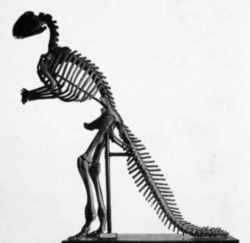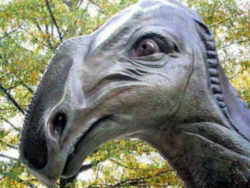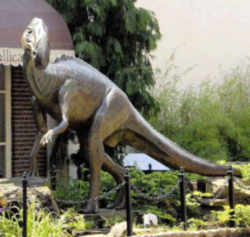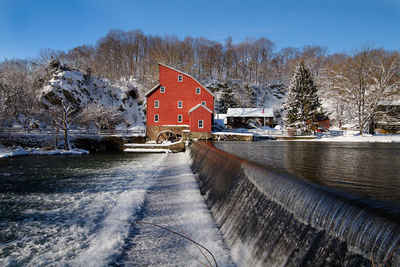New Jersey State Dinosaur
Duckbilled Dinosaur

(Hadrosaurus foulkii)
Adopted on June 13, 1991.
Hadrosaurus foulkii's promotion to "New Jersey State Dinosaur" began in 1988 at an elementary school in Haddon Township, a small community of about 15,000, located in western New Jersey east of Philadelphia when Strawbridge Elementary School teacher Joyce Berry initiated a project that would teach her fourth grade students about fossils as well as the New Jersey legislative process.
Many states had already named official state fossils and 1858's Hadrosaurus foulkii, the first nearly complete dinosaur skeleton ever discovered,
seemed a perfect representation for New Jersey. Ms. Berry's and her fourth-graders (97 students took part) lobbied intensely for Hadrosaurus foulkii,
only to have the state Senate ignore the proposal in 1990 after unanimous approval by the New Jersey Assembly (54-0).
As 1991 rolled around, things started looking up. By the end of May, 1991, the "Hadrosaurus bill," sponsored by Assemblymen John A. Rocco and Thomas J. Shusted, had been approved in both the Assembly and in the Senate.
Hadrosaurus foulkii became the New Jersey State Dinosaur when Governor Jim Florio signed the bill into law in the rotunda of the New Jersey State House on June 13, 1991.
New Jersey State Dinosaur: Duckbilled Dinosaur

Hadrosaurus from Greek, hadros, i.e. "sturdy" and sauros, i.e. "lizard") is a valid genus of hadrosaurid dinosaur. In 1858, the only known skeleton was discovered, representing the first dinosaur species known from more than isolated teeth to be identified in North America. In 1868, it became the first ever mounted dinosaur skeleton. Hadrosaurus foulkii is the only species in this genus and has been the official state dinosaur of New Jersey, United States since 1991
A duckbilled dinosaur, (Hadrosaurus foulkii,) roamed the forests and swamps along the bays of New Jersey's ancient seacoast. Today its bones are found in ancient marine deposits with fossil seashells. It was about twenty-five feet long, probably weighed 7 to 8 tons and stood about 10 feet tall. We think Hadrosaurus stood on its hind feet when running, but used it front feet to support its head while grazing. Its abundant blunt teeth confirm that Hadrosaurus was a vegetarian, a peaceful plant eater that could chew tough-stemmed twigs and leaves. Hadrosaurus lived about 80 million years ago late in the Cretaceous Period.
In the summer of 1858, Victorian gentleman and fossil hobbyist William Parker Foulke was vacationing in Haddonfield, New Jersey, when he heard that twenty years previous, workers had found gigantic bones in a local marl pit. Foulke spent the rest of the summer directing a crew of hired diggers shin deep in gray slime. Eventually he found the bones (above, right) of an animal larger than an elephant with structural features of both a lizard and a bird.
Foulke had discovered the first nearly-complete skeleton of a dinosaur -- an event that would rock the scientific world and forever change our view of natural history.
Hadrosaurus foulkii became the official State dinosaur of New Jersey in 1991 after years of hard work by a teacher, Joyce Berry, and her fourth grade classes at Strawbridge Elementary School in Haddon Township. As a result of their efforts, New Jersey has a truly unique symbol of its prehistoric past.
New Jersey Act of 1991
On June 13, 1991, with Ms. Berry and her students gathered around him in the rotunda of the State House, Governor Jim Florio signed the following legislation into law:
CHAPTER 161 OF THE LAWS OF NEW JERSEY OF 1991
An Act Designating the Hadrosaurus foulkii as the New Jersey State Dinosaur.
BE IT ENACTED by the Senate and General Assembly of the State of New Jersey:
1. The Legislature finds that:
a. The Hadrosaurus foulkii, the first nearly complete dinosaur skeleton to be discovered virtually intact anywhere in the world, was unearthed in October,
1858, in a marl pit in Haddonfield, Camden County, by William Parker Foulke, a member of the prestigious Academy of Natural Sciences of Philadelphia.
b. This discovery of a 25-foot, eight-ton, duck-billed, herbivorous saurian (or reptile), which stood as high as ten feet at the hips, was so unexpected
and unusual that it startled the scientific thinking of the day and led to a revision of many conventional ideas as to the physical structure and life
habits of prehistoric reptiles and provided a great stimulus to the study of dinosaurs which, until then, were relatively unknown outside the scientific
community.
c. This dinosaur, which lived 70 to 100 million years ago during the Cretaceous period and which was given the name Hadrosaurus foulkii in honor of
its discoverer, was the first dinosaur to be displayed for public view, attracting tens of thousands of visitors to the Academy of Natural Sciences
where it was on view from the 1870's to the 1940's.
d. The Hadrosaurus foulkii has been recently reinstalled as one of the main features in a permanent exhibit at the Academy of Natural Sciences.
e. In order to pay recognition to the scientific importance of New Jersey's Hadrosaurus foulkii, it is fitting and appropriate to designate it as the
State Dinosaur.
Approved June 13, 1991.
Taxonomic Hierarchy: Duckbilled Dinosaur
Kingdom: Animalia
Phylum: Chordata
Clade: Dinosauria
Order: Ornithischia
Clade: Ornithopoda
Family: Hadrosauridae
Subfamily: Hadrosaurinae
Genus: Hadrosaurus
Species: Hadrosaurus foulkiiLeidy, 1858

Some states that lack a "state fossil" have nevertheless singled out a fossil for formal designation such as a state dinosaur, rock, gem or stone.







